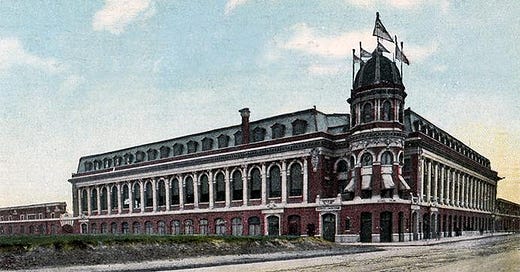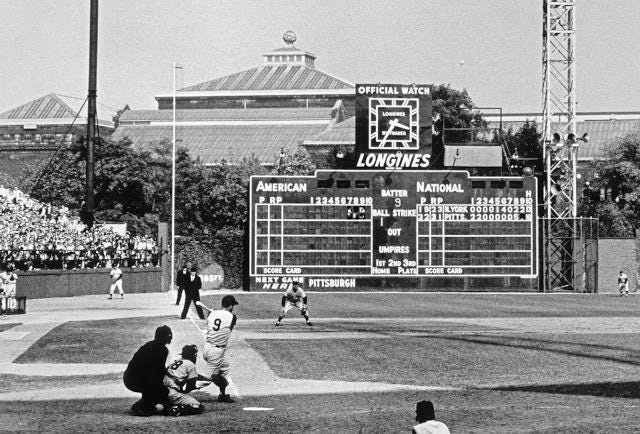Road Trip? More Like Road-Trippin'
Father of the Pod Chris Hailey takes us time traveling to the three historic ballparks he wishes he could have visited
Let’s stipulate up front that I’m the senior citizen of this blog (long time reader, first time contributor). As the designated Podfather of the No Dowd About It! podcast, it falls to me be a nostalgia freak rather than a Statcast savant. Instead of chasing you analytics kids off my lawn, I’d rather take a trip down a memory lane that I am old enough to appreciate, but too young to have traveled.
While economists, owners, and local governments worry about the economic impact of building a new stadium in Las Vegas, Nashville, Montreal, or Portland, all I’m thinking about is sitting in the stands with my son and my scorebook, having another great day at the old ballyard. It’s a shame that there are still a third of all MLB parks that I haven’t visited (more, really, since I’ve only been to former ballparks in Miami and the Bronx). But I have this weird fascination with the idea of hopping in my handy time travel machine with Mr. Peabody (look it up, Gen Z-ers) and going on the perfect baseball road trip to places that don’t exist anymore.
What makes an old-time ballpark special? Three things spring quickly to mind. Odd dimensions are aways fun, like the 251-foot left field line at the Los Angeles Coliseum when the Dodgers first came to LA. Next is fan proximity, especially in upper decks, where the viewers were right on top of the action. Finally, the placement within residential neighborhoods brings a charm that Truist Park and Kaufmann Stadium just can’t deliver.
Hop on board, Space and Time Cadets! We’re 1.21 jigowatts and 88 MPH away from the trip of several lifetimes. (Yeah, I know, that wasn’t Peabody and Sherman. Deal with it.)
Shibe Park, Philadelphia
In 1909 HKS Architects was decades away from its founding, so owner Ben Shibe and manager Connie Mack had a hand in designing the ultra-modern, French Renaissance-styled edifice. The façade looked like anything but a ballpark, replete with nearly eighty arches, a mansard roof, and most notably a tower topped with a cupola dome. The Athletics’ offices were housed in the tower, with Mack’s at the top. The original ballpark seated 23,000 and stood another 17,000. This was back when they’d just put up a rope and change the outfield dimensions by sticking thousands of (undoubtedly) well-behaved fans on the grass, just beyond the outfielders.
*It is worth noting that the exit of the Athletics to Kansas City in 1953 left the Phillies as the sole tenants of what was then known as Connie Mack Stadium. It took nearly twenty more years to replace the park, dilapidated and in a deteriorating neighborhood, with one of the least appealing stadiums in baseball.
Scene shifts to the sunny streets of Philadelphia
It’s October 12, 1929, and we’re strolling up Lehigh Avenue towards 21st street, game four World Series tickets in hand. We are about to witness something never seen in a postseason game, before or since.
Emerging through the Lehigh Avenue grandstand entrance, we get a beautiful view of the stands and field. The upper deck behind home plate is so steep that vertigo might set in, but seats at the front of those sections project almost as close to the field as the lower grandstand. Luckily, the outfield seats are no longer in suburban Pittsburgh, having been brought in from 378, 515, and 340 feet to more reasonable distances a few years ago. We’re sitting in the second row, down the left field line, our seats helpfully canted toward home plate starting at the cut of the outfield grass. We have a perfect view of Al Simmons (the Hall of Famer Formerly Known as Alois Szymanski) in left and Jimmy Dykes at third. Early in the game the two converge right in front of us, chasing a foul ball that my seatmate gathers in. (It’s my daydream, but a time machine is more realistic than me catching the ball).
The Cubbies spend five innings clobbering forty-five-year-old Jack Quinn, ultimately building an 8-0 lead. But the 7th inning brings a deluge of hits by the home team, the rally aided by errors and sun-induced misplays by center fielder Hack Wilson. Fifteen batters later, the A’s lead 10-8. Lefty Grove comes on in relief to record the final six outs, and Mack’s men are on their way to a 4-1 series win.
After two hours and twelve minutes, a few 15 cent hots dogs, and a Coke or two (state law prevented beer from being sold at the ballpark until 1961), we stroll on to our next destination.
Forbes Field, Pittsburgh
Forbes Field opened in 1909, one of the first modern steel and concrete ballparks. It was innovative in many respects, including a third deck that housed something akin to today’s luxury boxes, the first ramps to take fans to the upper reaches, and even elevators to get to the third deck. The exterior was handsome, though less ornate than Shibe Park in the eastern end of the state. It hosted greats from Honus Wagner to Pie Traynor to the incomparable Roberto Clemente. It lasted for more than sixty years before falling victim to the territorial conquest of the University of Pittsburgh, to replaced by yet another unappealing doughnut of a stadium.
I have the same image of Forbes Field that that most people have. It’s a pleasant fall afternoon. There is ivy on the walls and trees behind the outfield fences. There is a perfect, hand-operated scoreboard with a big Longines clock at the top. Next door on the U Pitt campus, the 535-foot Cathedral of Learning looms over the third base stands. You know what’s about to happen.
And the scene shifts 310 miles west and thirty-one years later.
We choose seats in right-center field at the far end of the upper deck. It’s a perfect place to watch the majestic Mickey Mantle in center, with an ok view of the slightly less majestic Yogi Berra in left. In right, we see the noble Clemente when the Yanks are at the plate. We also have a great view of the upper reaches of Cathy (what students call the Cathedral of Learning) where fans who aren’t lucky enough to get in the door are watching from the roof.
Let’s take a minute to appreciate the names of the players on the field today. Smoky, Vern, Rocky, and Gino. Clete, Moose, Yogi, and The Mick. You can’t get that list anymore.
This one is a barnburner. It’s no wonder that someday this will be called the greatest game ever played. (See below for the greatest baseball photo ever taken). Though the Yankees have won games 16-3, 10-0, and 12-0, the series is tied 3-3 and they are locked in a back-and-forth struggle. The Pirates jump out to a 4-0 lead after two, but the Yankees come storming back to take a 7-4 lead after eight. Right on cue, the home crowd is made delirious by a five-run bottom of the eight that puts the Pirates three outs away from glory. The Yankees respond, nearly crushing the hopes of the Bucco’s faithful, tying it up in the top of the ninth.
Yanks hurler Bill Terry had put out the Pirate’s fire in the eight, retiring Don Hoak to end the frame. In the last of the ninth, he manages two pitches. The second one sends Yogi back to the ivy-covered wall, only to watch the winning run sail over his head. Bill Mazeroski fights his way around the bases, waving his helmet in his right hand, barely able to find his way to the plate.
Though the game only lasts 2:38, I’m exhausted. I need a beer. I spilled the one I had all over my scorebook.
Polo Grounds, New York
It was enormous. It was oddly shaped. Everyone from Ruth to Mays to Marv Throneberry played there. Of the three great New York ballparks, it was probably the least loved and revered. I really want to see what it was like, especially from way back, way back, way back in center field.
There were several iterations of the Polo Grounds, only the first of which hosted polo matches (that died out in the 1870’s, but the name stuck). Polo Grounds III, the site of John McGraw’s first World Series victory in 1905, burned nearly to the ground in April 1911, but by June Polo Grounds IV had been designed and construction had progressed enough for the Giants to return. The extensions of the upper deck into both left and right fields were completed in 1923, creating the look that remained for the rest of its existence. After several decades of mixed success the Giants, faced with declining revenue and a deteriorating ballpark, lit out for the west with their Brooklyn rivals in 1957.
After four years without baseball, the Polo Grounds was resurrected to host the Mets for two years, but it was finally torn down to make way for affordable housing. It was replaced by another of the less (in fairness, not the least) appealing stadiums in baseball.
My trusty time machine could take me to any number of iconic games – The Shot Heard Round the World and The Catch spring to mind – but I’m a contrarian, so I’m taking a pair of Burner Boys (you’re welcome, Kevin Lee) to see the first game played by the Amazin’ Mets, April 11. 1962. Why? Because it was Amazin’, obviously.
Final shift of scene. It's the Big Apple!
We hop off the elevated train at 155th Street and buy tickets for the left field bleachers. Since I am a bit sun sensitive, our tickets are in the lower deck because the upper deck overhangs the lower by twenty-one feet. Ah, glorious shade. We note that the visiting Cardinals relief pitchers are far less comfortable. They are sitting on benches in what should be the warning track in left-center, 440 feet from home plate, with a pitifully small overhanging roof with a Rolaids ad on top. There will be many freezing cold and broiling hot days when the bullpen is left exposed to the worst that New York weather has to offer.
The game unfolds pretty much as expected. Roger Craig, the Mets starter, is nicked for five runs in three innings on the way to an 11-4 Mets loss, the first of 120 in their inaugural season. There are some highlights, though, including a home run by former Dodgers first baseman and future Mets manager Gil Hodges. Cardinals’ legend Stan Musial, now 41, rips one of his 725 career doubles. And I get to enjoy a famous Rheingold beer, having been tempted by the massive center field billboard. We stay long enough after the last out to watch the teams take the 500-foot walk across the field to dead center where they climb the steps to the clubhouses.
We head out into the streets of Manhattan, dazed with the spectacle of these last three games. What’s the next bit of history we can enjoy from the stands? Suggestions?
-CBH
Listen to the boys from @JonDowdBurner talk about their favorite ballparks on the latest episode of No Dowd About It!







